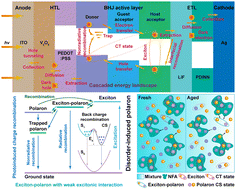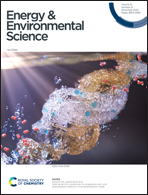Triggering favorable energy landscape: a general approach towards highly efficient and photostable organic solar cells†
Abstract
An unfavorable energy landscape can create intra-bandgap tail states, induce extra energy loss and enhance photocarrier trapping, thereby limiting both the performance and stability of non-fullerene organic solar cells (OSCs). Herein, a favorable energy landscape picture at the device level is conceived by a synergistic approach of interface modification and morphology control to overcome the conundrum between performance and stability in BTP-based OSCs. With synergistic optimization of bilayered interfaces and ternary strategies, the energetic disorder for the charge carrier transport and the generation of trap states have been obviously suppressed in target OSCs. The resultant favorable energy landscape with less energy losses and charge recombination leads to simultaneously improved efficiency and photostability in target OSCs based on multiple organic photovoltaic (OPV) systems. Moreover, the multiple approaches of photophysical characterization of neat acceptor and blend films reveal that light soaking induces an additionally unfavorable energy landscape, which intensifies the nonradiative trapping of exciton-polaron species formed by enhanced back charge recombination from electronic to excitonic excitations due to reduced energy barrier. These results emphasize the importance of constructing and stabilizing a favorable energy landscape in addressing the performance-photostability problem of BTP-based small molecules and all-polymer OSCs.



 Please wait while we load your content...
Please wait while we load your content...